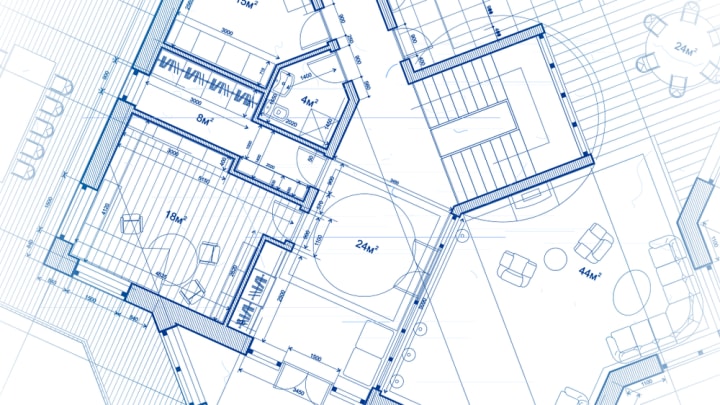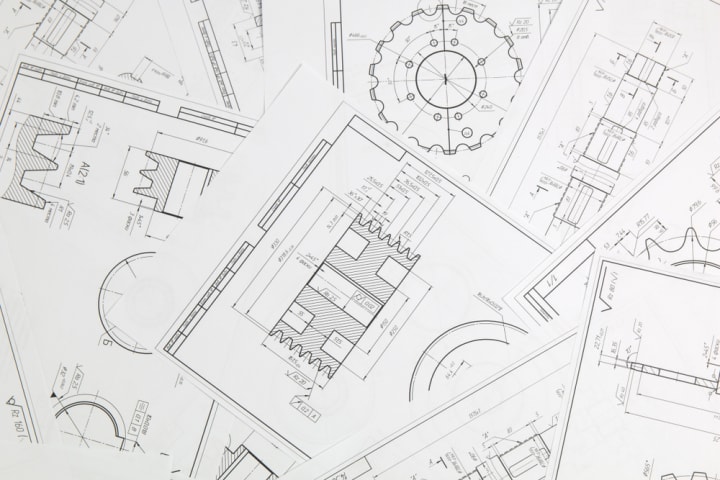10 Essential Elements to Include in Shop Drawings for Success
A shop drawing is a drawing or set of drawings produced by the contractor, supplier, manufacturer, subcontractor, consultants, or fabricator.

Shop drawings are used by almost everyone involved in the construction process - architects, engineers, contractors, builders, and other stakeholders. They serve as critical visual aids and blueprints for communicating crucial details about a project design to ensure everything is built according to plan.
When it comes to creating shop drawings that will actually help you achieve success, there are essential elements that absolutely have to be included. Let's face it: gone are the days of scribbling something down on a napkin and calling it "good enough." Instead, modern drawing is all about precision, accuracy, and attention to detail. To truly make your mark, you'll need to include things like measurements, scales, elevations, and even cut-away views.
Of course, it also helps to have a bit of creativity and problem-solving ability up your sleeve as well! At the end of the day, these shop drawings are what will allow you to take your project from concept all the way through construction - so take them seriously! Before delving deep into the essential elements to be included in shop drawings, let’s check out the benefits at a glance.
Why Need Shop Drawings for Construction?
- Reduced Errors: One of the major benefits of shop drawings in construction is that they help to reduce errors and ensure accurate fabrication and installation.
- Detailed Illustration of Components: Shop drawings provide a detailed illustration of how all the components of a project fit together, including measurements, materials, and specifications. This helps to minimize mistakes and ensure that everything fits precisely as designed.
- Minimized Delay & Rework: Additionally, shop drawings minimize delays and rework by identifying any potential issues before construction begins.
- Communicate Design Intent: They can be used to communicate design intent, coordinate multiple trades during prefabrication, and optimize production processes to achieve cost-effective solutions.
- Achieve Higher Level of Accuracy: Ultimately, shop drawings are an essential tool for any construction project that seeks to achieve high levels of accuracy, efficiency, and quality control throughout the building process.
Here are the 10 Essential Elements to Include in Shop Drawings:

When it comes to creating comprehensive and accurate shop drawings, there are several essential elements that must be included.
1. Part & Components - The drawings should clearly identify the parts and components of the project being manufactured. Part and components are an essential aspect of shop drawing because they provide crucial details that help teams to design, fabricate, and execute construction projects efficiently.
Benefits:
- Better understand intricacies of a project, like how each piece fits together to make up the whole structure.
- Level of precision while working on large construction projects where even the smallest error could result in costly renovations or delays.
- Enable product managers and manufacturers to purchase materials accurately and expedite production timelines.
- Ensure stakeholders have a clear understanding of project’s requirements from start to finish, resulting in smooth overall operations.
2. Measurements & Dimensions: The shop drawings should show measurements and dimensions accurately to ensure proper fit and function. Measurements and dimensions are vital in shop drawings because they provide detailed information about the components of a building or product.
Without accurate and precise measurements, errors can occur during fabrication, installation, and construction. Such mistakes can lead to delays in project completion, costly rework, and even safety hazards.
Benefits:
- Ensure team members are aligned with the same understanding of requirements
- Minimize misunderstandings over design specifications
- Quality assurance for stakeholders
- Reduced communication barriers between parties using different units of measurement
- Efficient process enabling everyone to focus on successful outcome - turning designs into reality
- Achieving clarity around crucial dimensions through well-defined shop drawings
- Fulfilled objectives with confidence while delivering optimal results, meeting client expectations

3. Material Specifications: Material specifications and tolerances should be indicated in detail to prevent any manufacturing defects or problems. Material specifications are necessary in shop drawings because they provide a detailed description of the materials that will be used in a construction project.
These specifications ensure that the correct type, grade, and quality of materials are procured and utilized, which is critical for achieving optimal performance and longevity of the structures.
Benefits:
- By specifying material properties, manufacturers' standards for fabrication can be upheld
- Avoiding any potential defects in the final product.
- Capture important details such as dimensions, finishing requirements, tolerance, load-bearing capacity and other technical information
- Facilitate accurate estimates from suppliers while avoiding any ambiguity or confusion about materials used in a construction project.
- Avoiding revisions during fabrication leading to cost overruns or unintended quality issues
- Ensuring smooth collaboration among construction professionals.
4. Assembly Instruction: Assembly instructions must be included for easy product implementation at the job site. Assembly instructions are indispensable in shop drawings for a myriad of reasons. First and foremost, they provide a clear and concise understanding of how various components or elements should be constructed, assembled or installed within a given structure.
These instructions outline the individual steps required to complete specific tasks, providing an invaluable reference point for builders and fabricators alike.
Benefits:
- Establish quality assurance guidelines, ensuring component manufacturing meets specified criteria.
- Reduce production costs by minimizing waste material and avoiding costly errors that may arise during installation.
- Utmost accuracy and precision for success for strong assembly instruction
5. Welding Details: All required finishing processes such as welding or shot blasting need to be presented in detail. Welding details are an essential aspect of shop drawings because they provide precise information regarding the execution of welding between different components.
These details include the type and size of welding needed, along with the location and position of welds, crucial information for both fabricators and on-site teams. Additionally, welding may require specific parameters like temperature range, gas or arc placements depending upon the materials being welded. Welding is a process that demands high accuracy and quality to ensure its longevity and structural strength.
Benefits:
- Ensure all those involved adhere to industry standards while performing their job responsibilities.
- Including quality specifications in shop drawings, manufacturers become efficient in making accurate end-products
- Cost reduction and timely delivery without any compromise on product quality.
6. Thread Type & Bolt Size: Details like thread type and bolt size for fasteners used in assemblies must not be missed out. In any construction project, accurate and precise shop drawings are essential for ensuring the success of the project.
Thread type and bolt size are critical components of a shop drawing because they ensure that the right bolts are used to secure various components together. Selecting an incorrect thread type can lead to catastrophic failures, including stripped threads or bolts that break under strain.
Therefore, designers must carefully consider and accurately specify the appropriate thread type and bolt size in their shop drawings.
Benefits:
- The correct thread type is crucial because it has an impact on the effectiveness of the bolt's grip, strength, and resistance to wear and tear.
- Similarly, bolt size is essential because too small a bolt will not provide adequate support, while too large a bolt can be cumbersome and risky in terms of increased loading capacity.
- Ensure safety, structural integrity, and reliability of connections between components throughout all stages of construction.
7. Labeling of Parts: Labeling of different parts or areas to avoid confusion during the installation process is important too. In any construction or manufacturing project, accurate and detailed specifications are essential for ensuring efficient and effective work.
This is why labeling of parts is a crucial component of shop drawings. By clearly identifying each part within the design, builders and manufacturers can easily visualize how the finished product will look, anticipate potential challenges during production, and ensure that all components are produced according to exact specifications.
Benefits:
- Labeled drawings improve communication among stakeholders, which minimizes confusion throughout the process.
- Without proper labeling, it becomes challenging to identify individual parts accurately and find replacement parts in case of breakage or malfunctioning on-site.
- Accurate labeling provides essential information from design to installation stages – ultimately leading to cost-effective and long-lasting structures or products.

8. Warnings about Potential Safety: Highlighted cautions or warnings about potential safety hazards can also help in preventing accidents. As a professional in the field of construction or engineering, it is imperative to take heed of any warnings about potential safety concerns in shop drawings.
These warnings serve as reminders of potential hazards that may be present in the finished product or during the construction process, such as electrical hazards or instability risks. Ignoring these warnings may lead to accidents and injuries on the job site, which can result in legal action and serious harm to workers or bystanders.
Therefore, it is important for professionals to review all shop drawings thoroughly and prioritize caution, when necessary,
Benefits:
- Adherence to safety guidelines demonstrates a commitment to professionalism, business practices
- Ensures quality work and avoids costly mistakes
- Meets industry standards and maintains a safe environment
9. Quality Checkpoints & Inspection Documentation: Quality control checkpoints and inspections documentation also need to be outlined in the shop drawing. They are critical components of shop drawings in any architectural or engineering project.
These documents ensure that the final product is safe, functional, and durable. The quality checkpoints validate that all essential details pertaining to safety, structural integrity, and functionality have been incorporated into the drawings. Inspection documents provide a guide for quality control checks at different stages of design and construction.
These include material selection, sizing of components, connection detailing, amongst other factors that ultimately impact the performance of the final product.
Benefits:
- Minimize misunderstandings & miscommunications amongst engineers, architects, fabricators
- Enforce uniform standards for quality control throughout every phase of a project's lifecycle
- Ensure high-quality shop drawings, resulting in optimal project outcome with satisfied clients
10. Stamping Approvals: Lastly stamping approvals from architects & engineers authorizing any changes is important, noting activity that deviates from original design specifications are subject to liability issues.
Stamping approvals are an integral part of the construct shop drawing process as they signify that a qualified engineer or architect has reviewed and approved the drawings for accuracy, safety, and adherence to building codes and regulations.
This step is essential in ensuring that construction projects move forward without errors or discrepancies that could lead to costly delays or even compromise the structural integrity of a building.
Benefits:
- Provide legal protection in case of any unforeseen circumstances.
- Professional-grade stamping demonstrates commitment to client satisfaction, quality workmanship, and professional responsibility.
- Without it, the construction industry would be fraught with liability issues and needless expenses.
- A critical aspect of construction documentation that helps build long-lasting infrastructure
- Meet sustainability goals, higher energy efficiency standards and accessible design
Also Read: How to create Effective Shop Drawings?
Final Thought
Having all these specifications in the shop drawings ensure that all parties involved understand the expectations of the project while minimizing errors during manufacturing and installation. The detailed and precise illustrations provide a clear roadmap for all parties involved in the construction process, from architects to contractors to fabricators.
This results in quality projects with minimal waste of resources. When properly executed, shop drawings can eliminate errors and inefficiencies that may otherwise lead to delays and increased costs. Seeking shop drawings may require additional resources and coordination, particularly if working with multiple stakeholders or complex designs.
Ultimately, the decision should be based on a thorough analysis of project requirements, budget constraints, and timelines. Opt for shop drawings from one of the competent BIM service providers and save time, reduce cost, and ensure project success.
About the Creator
Ryan Stein
I am a renowned author, speaker and educator on Building Information Modeling (BIM) technology in the Architecture, Engineering, and Construction (AEC) industry.






Comments
There are no comments for this story
Be the first to respond and start the conversation.